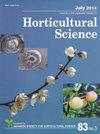Accumulation of Three Clubroot Resistance Genes through Marker-assisted Selection in Chinese Cabbage (Brassica rapa ssp. pekinensis).
Journal of The Japanese Society for Horticultural Science
Pub Date : 2012-04-01
DOI:10.2503/JJSHS1.81.184
引用次数: 67
Abstract
Many clubroot resistant (CR) cultivars of Chinese cabbage (Brassica rapa ssp. pekinensis) have been bred so far, but their usage is limited because the capacity for resistance breaks down with time. This degradation is caused by a pathogenic variation in the causal fungus Plasmodiophora brassicae. We attempted to accumulate 3 CR genes, CRa, CRk, and CRc, through marker-assisted selection. Five doubled haploid CR lines with an individual CR locus were used as breeding materials. The CR lines were crossed with each other. A subsequent selection for resistance was performed using sequence characterized amplified region markers in segregating generations. As a result, 4 homozygous lines for 3 resistance genes and the F1 hybrids between them were developed. CR pyramiding lines were inoculated with 6 field isolates of P. brassicae. The homozygous lines for 3 CR genes, whether selfed or crossed, exhibited exceedingly high resistance against all of the isolates. Morphological characters of F1 hybrids were comparable to those of a control cultivar, but the degree of heterosis was less than expected, which is probably because of genetic similarity of the parents. The results of this study prove that clubroot resistance can be reinforced through the accumulation of varied resistance genes in B. rapa.利用标记辅助选择积累3个白菜根瘤病抗性基因。学报)。
白菜(Brassica rapa ssp)抗根瘤病(CR)品种。到目前为止,人们已经培育出了北京品种,但由于抗性能力随着时间的推移而减弱,它们的使用受到限制。这种退化是由致病真菌brassicae Plasmodiophora致病变异引起的。我们试图通过标记辅助选择积累3个CR基因,CRa, CRk和CRc。以5个具有单个CR位点的双单倍体CR系为选育材料。CR系相互交叉。随后的抗性选择使用序列扩增区域标记在分离代中进行。结果,获得了3个抗性基因的4个纯合子系和它们之间的F1杂种。用6株大田菌株接种CR锥体系。3个CR基因的纯合子系,无论是自交还是杂交,对所有菌株都表现出极高的抗性。杂种F1的形态特征与对照品种相当,但杂种优势程度不及预期,这可能与亲本遗传相似性有关。本研究结果表明,油菜根茎抗性可以通过多种抗性基因的积累而增强。
本文章由计算机程序翻译,如有差异,请以英文原文为准。
求助全文
约1分钟内获得全文
求助全文
来源期刊
自引率
0.00%
发文量
0
审稿时长
>36 weeks

 求助内容:
求助内容: 应助结果提醒方式:
应助结果提醒方式:


